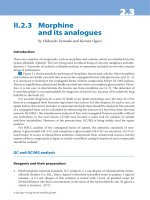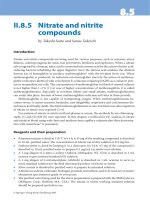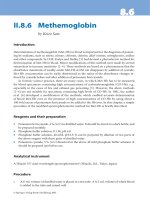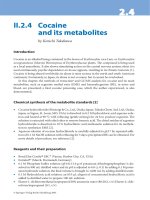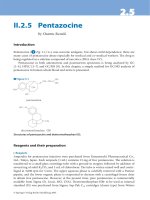Clean Code: A Handbook of Agile Software Craftsmanship pptx
Bạn đang xem bản rút gọn của tài liệu. Xem và tải ngay bản đầy đủ của tài liệu tại đây (3.18 MB, 462 trang )
www.it-ebooks.info
Clean Code
www.it-ebooks.info
Robert C. Martin Series
The mission of this series is to improve the state of the art of software craftsmanship.
The books in this series are technical, pragmatic, and substantial. The authors are
highly experienced craftsmen and professionals dedicated to writing about what
actually works in practice, as opposed to what might work in theory. You will read
about what the author has done, not what he thinks you should do. If the book is
about programming, there will be lots of code. If the book is about managing, there
will be lots of case studies from real projects.
These are the books that all serious practitioners will have on their bookshelves.
These are the books that will be remembered for making a difference and for guiding
professionals to become true craftsman.
Managing Agile Projects
Sanjiv Augustine
Agile Estimating and Planning
Mike Cohn
Working Effectively with Legacy Code
Michael C. Feathers
Agile Java™: Crafting Code with Test-Driven Development
Jeff Langr
Agile Principles, Patterns, and Practices in C#
Robert C. Martin and Micah Martin
Agile Software Development: Principles, Patterns, and Practices
Robert C. Martin
Clean Code: A Handbook of Agile Software Craftsmanship
Robert C. Martin
UML For Java™ Programmers
Robert C. Martin
Fit for Developing Software: Framework for Integrated Tests
Rick Mugridge and Ward Cunningham
Agile Software Development with SCRUM
Ken Schwaber and Mike Beedle
Extreme Software Engineering: A Hands on Approach
Daniel H. Steinberg and Daniel W. Palmer
For more information, visit informit.com/martinseries
www.it-ebooks.info
Clean Code
A Handbook of Agile
Software Craftsmanship
The Object Mentors:
Robert C. Martin
Michael C. Feathers Timothy R. Ottinger
Jeffrey J. Langr Brett L. Schuchert
James W. Grenning Kevin Dean Wampler
Object Mentor Inc.
Writing clean code is what you must do in order to call yourself a professional.
There is no reasonable excuse for doing anything less than your best.
Upper Saddle River, NJ • Boston • Indianapolis • San Francisco
New York • Toronto • Montreal • London • Munich • Paris • Madrid
Capetown • Sydney • Tokyo • Singapore • Mexico City
www.it-ebooks.info
Many of the designations used by manufacturers and sellers to distinguish their products are claimed as
trademarks. Where those designations appear in this book, and the publisher was aware of a trademark claim,
the designations have been printed with initial capital letters or in all capitals.
The authors and publisher have taken care in the preparation of this book, but make no expressed or
implied warranty of any kind and assume no responsibility for errors or omissions. No liability is assumed
for incidental or consequential damages in connection with or arising out of the use of the information or
programs contained herein.
The publisher offers excellent discounts on this book when ordered in quantity for bulk purchases or
special sales, which may include electronic versions and/or custom covers and content particular to your
business, training goals, marketing focus, and branding interests. For more information, please contact:
U.S. Corporate and Government Sales
(800) 382-3419
For sales outside the United States please contact:
International Sales
Includes bibliographical references and index.
ISBN 0-13-235088-2 (pbk. : alk. paper)
1. Agile software development. 2. Computer software—Reliability. I. Title.
QA76.76.D47M3652 2008
005.1—dc22 2008024750
Copyright © 2009 Pearson Education, Inc.
All rights reserved. Printed in the United States of America. This publication is protected by copyright,
and permission must be obtained from the publisher prior to any prohibited reproduction, storage in a
retrieval system, or transmission in any form or by any means, electronic, mechanical, photocopying,
recording, or likewise. For information regarding permissions, write to:
Pearson Education, Inc
Rights and Contracts Department
501 Boylston Street, Suite 900
Boston, MA 02116
Fax: (617) 671-3447
ISBN-13: 978-0-13-235088-4
ISBN-10: 0-13-235088-2
Text printed in the United States on recycled paper at Courier in Stoughton, Massachusetts.
First printing July, 2008
www.it-ebooks.info
For Ann Marie: The ever enduring love of my life.
www.it-ebooks.info
This page intentionally left blank
www.it-ebooks.info
vii
Contents
Foreword xix
Introduction xxv
On the Cover
xxix
Chapter 1: Clean Code 1
There Will Be Code 2
Bad Code 3
The Total Cost of Owning a Mess 4
The Grand Redesign in the Sky 5
Attitude 5
The Primal Conundrum 6
The Art of Clean Code? 6
What Is Clean Code? 7
Schools of Thought 12
We Are Authors 13
The Boy Scout Rule 14
Prequel and Principles 15
Conclusion 15
Bibliography 15
Chapter 2: Meaningful Names
17
Introduction 17
Use Intention-Revealing Names 18
Avoid Disinformation 19
Make Meaningful Distinctions 20
Use Pronounceable Names 21
Use Searchable Names 22
www.it-ebooks.info
viii Contents
Avoid Encodings 23
Hungarian Notation 23
Member Prefixes 24
Interfaces and Implementations 24
Avoid Mental Mapping 25
Class Names 25
Method Names 25
Don’t Be Cute 26
Pick One Word per Concept 26
Don’t Pun 26
Use Solution Domain Names 27
Use Problem Domain Names 27
Add Meaningful Context 27
Don’t Add Gratuitous Context 29
Final Words 30
Chapter 3: Functions
31
Small! 34
Blocks and Indenting 35
Do One Thing 35
Sections within Functions 36
One Level of Abstraction per Function 36
Reading Code from Top to Bottom: The Stepdown Rule 37
Switch Statements 37
Use Descriptive Names 39
Function Arguments 40
Common Monadic Forms 41
Flag Arguments 41
Dyadic Functions 42
Triads 42
Argument Objects 43
Argument Lists 43
Verbs and Keywords 43
Have No Side Effects 44
Output Arguments 45
Command Query Separation 45
www.it-ebooks.info
ixContents
Prefer Exceptions to Returning Error Codes 46
Extract Try/Catch Blocks 46
Error Handling Is One Thing 47
The
Error.java
Dependency Magnet 47
Don’t Repeat Yourself 48
Structured Programming 48
How Do You Write Functions Like This? 49
Conclusion 49
SetupTeardownIncluder
50
Bibliography 52
Chapter 4: Comments
53
Comments Do Not Make Up for Bad Code 55
Explain Yourself in Code 55
Good Comments 55
Legal Comments 55
Informative Comments 56
Explanation of Intent 56
Clarification 57
Warning of Consequences 58
TODO Comments 58
Amplification 59
Javadocs in Public APIs 59
Bad Comments 59
Mumbling 59
Redundant Comments 60
Misleading Comments 63
Mandated Comments 63
Journal Comments 63
Noise Comments 64
Scary Noise 66
Don’t Use a Comment When You Can Use a
Function or a Variable 67
Position Markers 67
Closing Brace Comments 67
Attributions and Bylines 68
www.it-ebooks.info
x Contents
Commented-Out Code 68
HTML Comments 69
Nonlocal Information 69
Too Much Information 70
Inobvious Connection 70
Function Headers 70
Javadocs in Nonpublic Code 71
Example 71
Bibliography 74
Chapter 5: Formatting
75
The Purpose of Formatting 76
Vertical Formatting 76
The Newspaper Metaphor 77
Vertical Openness Between Concepts 78
Vertical Density 79
Vertical Distance 80
Vertical Ordering 84
Horizontal Formatting 85
Horizontal Openness and Density 86
Horizontal Alignment 87
Indentation 88
Dummy Scopes 90
Team Rules 90
Uncle Bob’s Formatting Rules 90
Chapter 6: Objects and Data Structures
93
Data Abstraction 93
Data/Object Anti-Symmetry 95
The Law of Demeter 97
Train Wrecks 98
Hybrids 99
Hiding Structure 99
Data Transfer Objects 100
Active Record 101
Conclusion 101
Bibliography 101
www.it-ebooks.info
xiContents
Chapter 7: Error Handling
103
Use Exceptions Rather Than Return Codes 104
Write Your
Try-Catch-Finally
Statement First 105
Use Unchecked Exceptions 106
Provide Context with Exceptions 107
Define Exception Classes in Terms of a Caller’s Needs 107
Define the Normal Flow 109
Don’t Return Null 110
Don’t Pass Null 111
Conclusion 112
Bibliography 112
Chapter 8: Boundaries 113
Using Third-Party Code 114
Exploring and Learning Boundaries 116
Learning
log4j
116
Learning Tests Are Better Than Free 118
Using Code That Does Not Yet Exist 118
Clean Boundaries 120
Bibliography 120
Chapter 9: Unit Tests 121
The Three Laws of TDD 122
Keeping Tests Clean 123
Tests Enable the -ilities 124
Clean Tests 124
Domain-Specific Testing Language 127
A Dual Standard 127
One Assert per Test 130
Single Concept per Test 131
F.I.R.S.T 132
Conclusion 133
Bibliography 133
Chapter 10: Classes 135
Class Organization 136
Encapsulation 136
www.it-ebooks.info
xii Contents
Classes Should Be Small! 136
The Single Responsibility Principle 138
Cohesion 140
Maintaining Cohesion Results in Many Small Classes 141
Organizing for Change 147
Isolating from Change 149
Bibliography 151
Chapter 11: Systems 153
How Would You Build a City? 154
Separate Constructing a System from Using It 154
Separation of Main 155
Factories 155
Dependency Injection 157
Scaling Up 157
Cross-Cutting Concerns 160
Java Proxies 161
Pure Java AOP Frameworks 163
AspectJ Aspects 166
Test Drive the System Architecture 166
Optimize Decision Making 167
Use Standards Wisely, When They Add Demonstrable Value 168
Systems Need Domain-Specific Languages 168
Conclusion 169
Bibliography 169
Chapter 12: Emergence 171
Getting Clean via Emergent Design 171
Simple Design Rule 1: Runs All the Tests 172
Simple Design Rules 2–4: Refactoring 172
No Duplication 173
Expressive 175
Minimal Classes and Methods 176
Conclusion 176
Bibliography 176
Chapter 13: Concurrency 177
Why Concurrency? 178
Myths and Misconceptions 179
www.it-ebooks.info
xiiiContents
Challenges 180
Concurrency Defense Principles 180
Single Responsibility Principle 181
Corollary: Limit the Scope of Data 181
Corollary: Use Copies of Data 181
Corollary: Threads Should Be as Independent as Possible 182
Know Your Library 182
Thread-Safe Collections 182
Know Your Execution Models 183
Producer-Consumer 184
Readers-Writers 184
Dining Philosophers 184
Beware Dependencies Between Synchronized Methods 185
Keep Synchronized Sections Small 185
Writing Correct Shut-Down Code Is Hard 186
Testing Threaded Code 186
Treat Spurious Failures as Candidate Threading Issues 187
Get Your Nonthreaded Code Working First 187
Make Your Threaded Code Pluggable 187
Make Your Threaded Code Tunable 187
Run with More Threads Than Processors 188
Run on Different Platforms 188
Instrument Your Code to Try and Force Failures 188
Hand-Coded 189
Automated 189
Conclusion 190
Bibliography 191
Chapter 14: Successive Refinement 193
Args Implementation 194
How Did I Do This? 200
Args: The Rough Draft 201
So I Stopped 212
On Incrementalism 212
String Arguments 214
Conclusion 250
www.it-ebooks.info
xiv Contents
Chapter 15: JUnit Internals 251
The JUnit Framework 252
Conclusion 265
Chapter 16: Refactoring
SerialDate
267
First, Make It Work 268
Then Make It Right 270
Conclusion 284
Bibliography 284
Chapter 17: Smells and Heuristics 285
Comments 286
C1: Inappropriate Information 286
C2: Obsolete Comment 286
C3: Redundant Comment 286
C4: Poorly Written Comment 287
C5: Commented-Out Code 287
Environment 287
E1: Build Requires More Than One Step 287
E2: Tests Require More Than One Step 287
Functions 288
F1: Too Many Arguments 288
F2: Output Arguments 288
F3: Flag Arguments 288
F4: Dead Function 288
General 288
G1: Multiple Languages in One Source File 288
G2: Obvious Behavior Is Unimplemented 288
G3: Incorrect Behavior at the Boundaries 289
G4: Overridden Safeties 289
G5: Duplication 289
G6: Code at Wrong Level of Abstraction 290
G7: Base Classes Depending on Their Derivatives 291
G8: Too Much Information 291
G9: Dead Code 292
G10: Vertical Separation 292
G11: Inconsistency 292
G12: Clutter 293
www.it-ebooks.info
xvContents
G13: Artificial Coupling 293
G14: Feature Envy 293
G15: Selector Arguments 294
G16: Obscured Intent 295
G17: Misplaced Responsibility 295
G18: Inappropriate Static 296
G19: Use Explanatory Variables 296
G20: Function Names Should Say What They Do 297
G21: Understand the Algorithm 297
G22: Make Logical Dependencies Physical 298
G23: Prefer Polymorphism to If/Else or Switch/Case 299
G24: Follow Standard Conventions 299
G25: Replace Magic Numbers with Named Constants 300
G26: Be Precise 301
G27: Structure over Convention 301
G28: Encapsulate Conditionals 301
G29: Avoid Negative Conditionals 302
G30: Functions Should Do One Thing 302
G31: Hidden Temporal Couplings 302
G32: Don’t Be Arbitrary 303
G33: Encapsulate Boundary Conditions 304
G34: Functions Should Descend Only
One Level of Abstraction 304
G35: Keep Configurable Data at High Levels 306
G36: Avoid Transitive Navigation 306
Java 307
J1: Avoid Long Import Lists by Using Wildcards 307
J2: Don’t Inherit Constants 307
J3: Constants versus Enums 308
Names 309
N1: Choose Descriptive Names 309
N2: Choose Names at the Appropriate Level of Abstraction 311
N3: Use Standard Nomenclature Where Possible 311
N4: Unambiguous Names 312
N5: Use Long Names for Long Scopes 312
N6: Avoid Encodings 312
N7: Names Should Describe Side-Effects. 313
www.it-ebooks.info
xvi Contents
Tests 313
T1: Insufficient Tests 313
T2: Use a Coverage Tool! 313
T3: Don’t Skip Trivial Tests 313
T4: An Ignored Test Is a Question about an Ambiguity 313
T5: Test Boundary Conditions 314
T6: Exhaustively Test Near Bugs 314
T7: Patterns of Failure Are Revealing 314
T8: Test Coverage Patterns Can Be Revealing 314
T9: Tests Should Be Fast 314
Conclusion 314
Bibliography 315
Appendix A: Concurrency II 317
Client/Server Example 317
The Server 317
Adding Threading 319
Server Observations 319
Conclusion 321
Possible Paths of Execution 321
Number of Paths 322
Digging Deeper 323
Conclusion 326
Knowing Your Library 326
Executor Framework 326
Nonblocking Solutions 327
Nonthread-Safe Classes 328
Dependencies Between Methods
Can Break Concurrent Code 329
Tolerate the Failure 330
Client-Based Locking 330
Server-Based Locking 332
Increasing Throughput 333
Single-Thread Calculation of Throughput 334
Multithread Calculation of Throughput 335
Deadlock 335
Mutual Exclusion 336
Lock & Wait 337
www.it-ebooks.info
xviiContents
No Preemption 337
Circular Wait 337
Breaking Mutual Exclusion 337
Breaking Lock & Wait 338
Breaking Preemption 338
Breaking Circular Wait 338
Testing Multithreaded Code 339
Tool Support for Testing Thread-Based Code 342
Conclusion 342
Tutorial: Full Code Examples 343
Client/Server Nonthreaded 343
Client/Server Using Threads 346
Appendix B: org.jfree.date.SerialDate 349
Appendix C: Cross References of Heuristics 409
Epilogue 411
Index 413
www.it-ebooks.info
This page intentionally left blank
www.it-ebooks.info
xix
Foreword
One of our favorite candies here in Denmark is Ga-Jol, whose strong licorice vapors are a
perfect complement to our damp and often chilly weather. Part of the charm of Ga-Jol to
us Danes is the wise or witty sayings printed on the flap of every box top. I bought a two-
pack of the delicacy this morning and found that it bore this old Danish saw:
Ærlighed i små ting er ikke nogen lille ting.
“Honesty in small things is not a small thing.” It was a good omen consistent with what I
already wanted to say here. Small things matter. This is a book about humble concerns
whose value is nonetheless far from small.
God is in the details, said the architect Ludwig mies van der Rohe. This quote recalls
contemporary arguments about the role of architecture in software development, and par-
ticularly in the Agile world. Bob and I occasionally find ourselves passionately engaged in
this dialogue. And yes, mies van der Rohe was attentive to utility and to the timeless forms
of building that underlie great architecture. On the other hand, he also personally selected
every doorknob for every house he designed. Why? Because small things matter.
In our ongoing “debate” on TDD, Bob and I have discovered that we agree that soft-
ware architecture has an important place in development, though we likely have different
visions of exactly what that means. Such quibbles are relatively unimportant, however,
because we can accept for granted that responsible professionals give some time to think-
ing and planning at the outset of a project. The late-1990s notions of design driven only by
the tests and the code are long gone. Yet attentiveness to detail is an even more critical
foundation of professionalism than is any grand vision. First, it is through practice in the
small that professionals gain proficiency and trust for practice in the large. Second, the
smallest bit of sloppy construction, of the door that does not close tightly or the slightly
crooked tile on the floor, or even the messy desk, completely dispels the charm of the
larger whole. That is what clean code is about.
Still, architecture is just one metaphor for software development, and in particular for
that part of software that delivers the initial product in the same sense that an architect
delivers a pristine building. In these days of Scrum and Agile, the focus is on quickly
bringing product to market. We want the factory running at top speed to produce software.
These are human factories: thinking, feeling coders who are working from a product back-
log or user story to create product. The manufacturing metaphor looms ever strong in such
thinking. The production aspects of Japanese auto manufacturing, of an assembly-line
world, inspire much of Scrum.
www.it-ebooks.info
xx Foreword
Yet even in the auto industry, the bulk of the work lies not in manufacturing but in
maintenance—or its avoidance. In software, 80% or more of what we do is quaintly called
“maintenance”: the act of repair. Rather than embracing the typical Western focus on pro-
ducing good software, we should be thinking more like home repairmen in the building
industry, or auto mechanics in the automotive field. What does Japanese management have
to say about that?
In about 1951, a quality approach called Total Productive Maintenance (TPM) came
on the Japanese scene. Its focus is on maintenance rather than on production. One of the
major pillars of TPM is the set of so-called 5S principles. 5S is a set of disciplines—and
here I use the term “discipline” instructively. These 5S principles are in fact at the founda-
tions of Lean—another buzzword on the Western scene, and an increasingly prominent
buzzword in software circles. These principles are not an option. As Uncle Bob relates in
his front matter, good software practice requires such discipline: focus, presence of mind,
and thinking. It is not always just about doing, about pushing the factory equipment to pro-
duce at the optimal velocity. The 5S philosophy comprises these concepts:
• Seiri, or organization (think “sort” in English). Knowing where things are—using
approaches such as suitable naming—is crucial. You think naming identifiers isn’t
important? Read on in the following chapters.
• Seiton, or tidiness (think “systematize” in English). There is an old American saying:
A place for everything, and everything in its place. A piece of code should be where
you expect to find it—and, if not, you should re-factor to get it there.
• Seiso, or cleaning (think “shine” in English): Keep the workplace free of hanging
wires, grease, scraps, and waste. What do the authors here say about littering your
code with comments and commented-out code lines that capture history or wishes for
the future? Get rid of them.
• Seiketsu, or standardization: The group agrees about how to keep the workplace clean.
Do you think this book says anything about having a consistent coding style and set of
practices within the group? Where do those standards come from? Read on.
• Shutsuke, or discipline (self-discipline). This means having the discipline to follow the
practices and to frequently reflect on one’s work and be willing to change.
If you take up the challenge—yes, the challenge—of reading and applying this book,
you’ll come to understand and appreciate the last point. Here, we are finally driving to the
roots of responsible professionalism in a profession that should be concerned with the life
cycle of a product. As we maintain automobiles and other machines under TPM, break-
down maintenance—waiting for bugs to surface—is the exception. Instead, we go up a
level: inspect the machines every day and fix wearing parts before they break, or do the
equivalent of the proverbial 10,000-mile oil change to forestall wear and tear. In code,
refactor mercilessly. You can improve yet one level further, as the TPM movement inno-
vated over 50 years ago: build machines that are more maintainable in the first place. Mak-
ing your code readable is as important as making it executable. The ultimate practice,
introduced in TPM circles around 1960, is to focus on introducing entire new machines or
www.it-ebooks.info
xxiForeword
replacing old ones. As Fred Brooks admonishes us, we should probably re-do major soft-
ware chunks from scratch every seven years or so to sweep away creeping cruft. Perhaps
we should update Brooks’ time constant to an order of weeks, days or hours instead of
years. That’s where detail lies.
There is great power in detail, yet there is something humble and profound about this
approach to life, as we might stereotypically expect from any approach that claims Japa-
nese roots. But this is not only an Eastern outlook on life; English and American folk wis-
dom are full of such admonishments. The Seiton quote from above flowed from the pen of
an Ohio minister who literally viewed neatness “as a remedy for every degree of evil.”
How about Seiso? Cleanliness is next to godliness. As beautiful as a house is, a messy
desk robs it of its splendor. How about Shutsuke in these small matters? He who is faithful
in little is faithful in much. How about being eager to re-factor at the responsible time,
strengthening one’s position for subsequent “big” decisions, rather than putting it off? A
stitch in time saves nine. The early bird catches the worm. Don’t put off until tomorrow
what you can do today. (Such was the original sense of the phrase “the last responsible
moment” in Lean until it fell into the hands of software consultants.) How about calibrat-
ing the place of small, individual efforts in a grand whole? Mighty oaks from little acorns
grow. Or how about integrating simple preventive work into everyday life? An ounce of
prevention is worth a pound of cure. An apple a day keeps the doctor away. Clean code
honors the deep roots of wisdom beneath our broader culture, or our culture as it once was,
or should be, and can be with attentiveness to detail.
Even in the grand architectural literature we find saws that hark back to these sup-
posed details. Think of mies van der Rohe’s doorknobs. That’s seiri. That’s being attentive
to every variable name. You should name a variable using the same care with which you
name a first-born child.
As every homeowner knows, such care and ongoing refinement never come to an end.
The architect Christopher Alexander—father of patterns and pattern languages—views
every act of design itself as a small, local act of repair. And he views the craftsmanship of
fine structure to be the sole purview of the architect; the larger forms can be left to patterns
and their application by the inhabitants. Design is ever ongoing not only as we add a new
room to a house, but as we are attentive to repainting, replacing worn carpets, or upgrad-
ing the kitchen sink. Most arts echo analogous sentiments. In our search for others who
ascribe God’s home as being in the details, we find ourselves in the good company of the
19th century French author Gustav Flaubert. The French poet Paul Valery advises us that a
poem is never done and bears continual rework, and to stop working on it is abandonment.
Such preoccupation with detail is common to all endeavors of excellence. So maybe there
is little new here, but in reading this book you will be challenged to take up good disci-
plines that you long ago surrendered to apathy or a desire for spontaneity and just
“responding to change.”
Unfortunately, we usually don’t view such concerns as key cornerstones of the art of
programming. We abandon our code early, not because it is done, but because our value
system focuses more on outward appearance than on the substance of what we deliver.
www.it-ebooks.info
xxii Foreword
This inattentiveness costs us in the end: A bad penny always shows up. Research, neither in
industry nor in academia, humbles itself to the lowly station of keeping code clean. Back
in my days working in the Bell Labs Software Production Research organization (Produc-
tion, indeed!) we had some back-of-the-envelope findings that suggested that consistent
indentation style was one of the most statistically significant indicators of low bug density.
We want it to be that architecture or programming language or some other high notion
should be the cause of quality; as people whose supposed professionalism owes to the
mastery of tools and lofty design methods, we feel insulted by the value that those factory-
floor machines, the coders, add through the simple consistent application of an indentation
style. To quote my own book of 17 years ago, such style distinguishes excellence from
mere competence. The Japanese worldview understands the crucial value of the everyday
worker and, more so, of the systems of development that owe to the simple, everyday
actions of those workers. Quality is the result of a million selfless acts of care—not just of
any great method that descends from the heavens. That these acts are simple doesn’t mean
that they are simplistic, and it hardly means that they are easy. They are nonetheless the
fabric of greatness and, more so, of beauty, in any human endeavor. To ignore them is not
yet to be fully human.
Of course, I am still an advocate of thinking at broader scope, and particularly of the
value of architectural approaches rooted in deep domain knowledge and software usability.
The book isn’t about that—or, at least, it isn’t obviously about that. This book has a subtler
message whose profoundness should not be underappreciated. It fits with the current saw
of the really code-based people like Peter Sommerlad, Kevlin Henney and Giovanni
Asproni. “The code is the design” and “Simple code” are their mantras. While we must
take care to remember that the interface is the program, and that its structures have much
to say about our program structure, it is crucial to continuously adopt the humble stance
that the design lives in the code. And while rework in the manufacturing metaphor leads to
cost, rework in design leads to value. We should view our code as the beautiful articulation
of noble efforts of design—design as a process, not a static endpoint. It’s in the code that
the architectural metrics of coupling and cohesion play out. If you listen to Larry Constan-
tine describe coupling and cohesion, he speaks in terms of code—not lofty abstract con-
cepts that one might find in UML. Richard Gabriel advises us in his essay, “Abstraction
Descant” that abstraction is evil. Code is anti-evil, and clean code is perhaps divine.
Going back to my little box of Ga-Jol, I think it’s important to note that the Danish
wisdom advises us not just to pay attention to small things, but also to be honest in small
things. This means being honest to the code, honest to our colleagues about the state of our
code and, most of all, being honest with ourselves about our code. Did we Do our Best to
“leave the campground cleaner than we found it”? Did we re-factor our code before check-
ing in? These are not peripheral concerns but concerns that lie squarely in the center of
Agile values. It is a recommended practice in Scrum that re-factoring be part of the con-
cept of “Done.” Neither architecture nor clean code insist on perfection, only on honesty
and doing the best we can. To err is human; to forgive, divine. In Scrum, we make every-
thing visible. We air our dirty laundry. We are honest about the state of our code because
www.it-ebooks.info
xxiiiForeword
code is never perfect. We become more fully human, more worthy of the divine, and closer
to that greatness in the details.
In our profession, we desperately need all the help we can get. If a clean shop floor
reduces accidents, and well-organized shop tools increase productivity, then I’m all for
them. As for this book, it is the best pragmatic application of Lean principles to software I
have ever seen in print. I expected no less from this practical little group of thinking indi-
viduals that has been striving together for years not only to become better, but also to gift
their knowledge to the industry in works such as you now find in your hands. It leaves the
world a little better than I found it before Uncle Bob sent me the manuscript.
Having completed this exercise in lofty insights, I am off to clean my desk.
James O. Coplien
Mørdrup, Denmark
www.it-ebooks.info
This page intentionally left blank
www.it-ebooks.info




